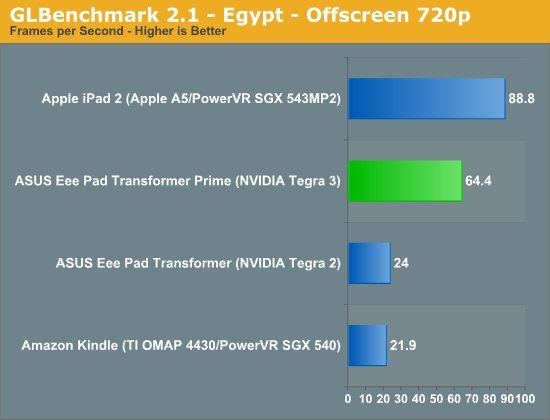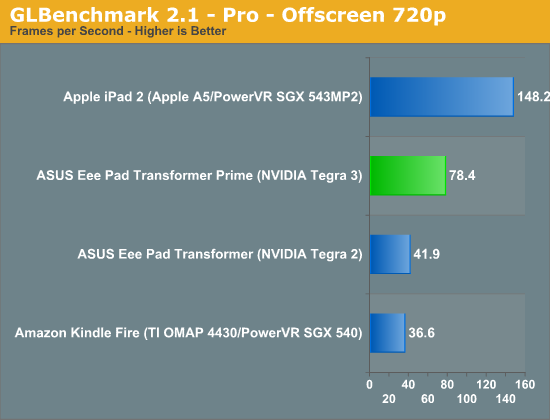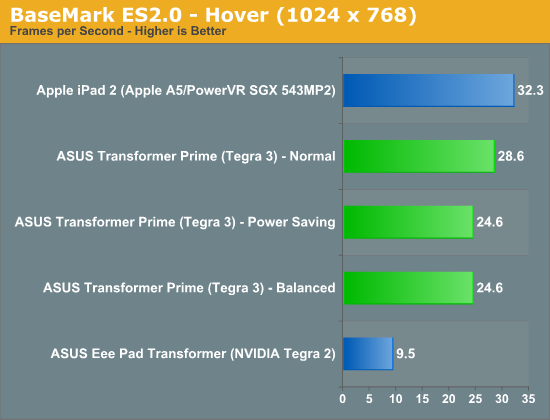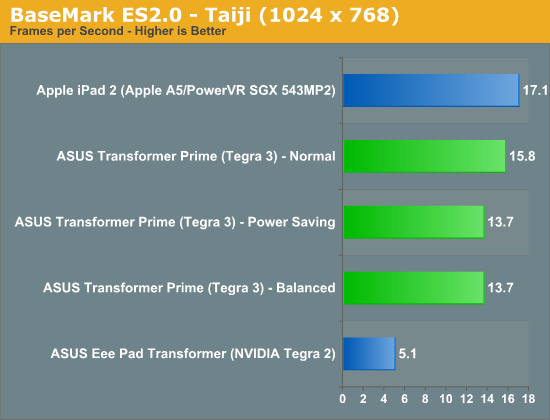ASUS Eee Pad Transformer Prime & NVIDIA Tegra 3 Review
by Anand Lal Shimpi on December 1, 2011 1:00 AM ESTTegra 3 GPU: Making Honeycomb Buttery Smooth
The bigger impact on the overall experience is the Tegra 3's GPU. If you remember back to our initial analysis of Tegra 3 you'll know that the GPU is not only clocked higher but it also has more execution resources at its disposal. To further improve performance, per "core" efficiency is up thanks to some larger internal data structures and tweaks. The end result is much better gaming performance as well as a much smoother UI.
Tasks like bringing up the apps launcher or even swiping between home screens are finally far above 30 fps. While Tegra 2 didn't have the fill rate to deal with some of the more complex overlays in Honeycomb, Tegra 3 does. The move to Tegra 3 makes the Honeycomb experience so much better. This is what it should've been like from the start.
Gaming performance is also significantly better as you can see from our standard collection of Android GPU benchmarks:




Performance is still not quite up to par with the iPad 2, but if we look at GLBenchmark's Egypt test Tegra 3 doesn't do too bad. The gap grows in more texture bound tests but in a heavier shader environment Tegra 3 isn't too shabby. While it's clear that Tegra 2 wasn't enough to deal with the 1280 x 752 resolution of Honeycomb tablets, Tegra 3 seems well matched.
Note that the BaseMark ES2.0 tests run at FP16 on Tegra 2 and 3 vs. FP24 on the PowerVR SGX 543MP2.










204 Comments
View All Comments
abcgum091 - Thursday, December 1, 2011 - link
After seeing the performance benchmarks, Its safe to say that the ipad 2 is an efficiency marvel. I don't believe I will be buying a tablet until windows 8 is out.ltcommanderdata - Thursday, December 1, 2011 - link
I'm guessing the browser and most other apps are not well optimized for quad cores. The question is will developers actually bother focusing on quad cores? Samsung is going with fast dual core A15 in it's next Exynos. The upcoming TI OMAP 4470 is a high clock speed dual core A9 and OMAP5 seem to be high clock speed dual core A15. If everyone else standardizes on fast dual cores, Tegra 3 and it's quad cores may well be a check box feature that doesn't see much use putting it at a disadvantage.Wiggy McShades - Thursday, December 1, 2011 - link
If the developer is writing something in java (most likely native code applications too) it would be more work for them to ensure they are at most using 2 threads instead of just creating as many threads as needed. The amount of threads a java application can create and use is not limited to the number of cores on the cpu. If you created 4 threads and there are 2 cores then the 4 threads will be split between the two cores. The 2 threads per core will take turns executing with the thread who has the highest priority getting more executing time than the other. All non real time operating systems are constantly pausing threads to let another run, that's how multitasking existed before we had dual core cpu's. The easiest way to write an application that takes advantage of multiple threads is to split up the application into pieces that can run independently of each other, the amount of pieces being dependent on the type of application it is. Essentially if a developer is going to write a threaded application the amount of threads he will use will be determined by what the application is meant to do rather than the cores he believes will be available. The question to ask is what kind of application could realistically use more than 2 threads and can that application be used on a tablet.Operaa - Monday, January 16, 2012 - link
Making responsive today UI most certainly requires you to use threads, so shouldn't be big problem. I'd say 2 threads per application is absolutely a minimum. For example, talking about browsing web, I would imagine useful to handle ui in one thread, loading page in one, loading pictures in third and running flash in fourth (or more), etc.UpSpin - Thursday, December 1, 2011 - link
ARM introduced big.LITTLE which only makes sense in Quad or more core systems.NVIDIA is the only company with a Quad core right now because they integrated this big.LITTLE idea already. Without such a companion core does a quad core consume too much power.
So I think Samsung released a A15 dual core because it's easier and they are able to release a A15 SoC earlier. They'll work on a Quad core or six or eight core, but then they have to use the big.LITTLE idea, which probably takes a few more months of testing.
And as we all know, time is money.
metafor - Thursday, December 1, 2011 - link
/bogglebig.Little can work with any configuration and works just as well. Even in quad-core, individual cores can be turned off. The companion core is there because even at the lowest throttled level, a full core will still produce a lot of leakage current. A core made with lower-leakage (but slower) transistors can solve this.
Also, big.Little involves using different CPU architectures. For example, an A15 along with an A7.
nVidia's solution is the first step, but it only uses A9's for all of the cores.
UpSpin - Friday, December 2, 2011 - link
I haven't said anything different. I just added that Samsung wants to be one of the first who release a A15 SoC. To speed things up they released a dual core only, because there the advantage of a companion core isn't that big and the leakage current is 'ok'. It just makes the dual core more expensive (additional transistors needed, without such a huge advantage)But if you want to build a quad core, you must, just as Nvidia did, add such a companion core, else the leakage current is too high. But integrating the big.LITTLE idea probably takes additional time, thus they wouldn't be the first who produced a A15 based SoC.
So to be one of the first, they chose to take the easiest design, a dual core A15. After a few months and additional time of RD they will release a quad core with big.LITTLE and probably a dual core and six core and eigth core with big.LITTLE, too.
hob196 - Friday, December 2, 2011 - link
You said:"ARM introduced big.LITTLE which only makes sense in Quad or more core systems"
big.LITTLE would apply to single core systems if the A7 and A15 pairing was considered one core.
UpSpin - Friday, December 2, 2011 - link
Power consumption wise it makes sense to pair an A7 with a single and dual core already.Cost wise it doesn't really make sense.
I really doubt that we will see some single core A15 SoC with a companion core. And dual core, maybe, but not at the beginning.
GnillGnoll - Friday, December 2, 2011 - link
It doesn't matter how many "big" cores there are, big.LITTLE is for those situations where turning on even a single "big" core is a relatively large power draw.A quad core with three cores power gated has no more leakage than a single core chip.